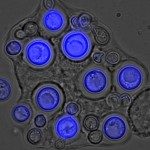Lien vers Pubmed [PMID] – 24861577
Clin. Microbiol. Infect. 2014 Nov;20(11):O952-9
Posaconazole (PSC) is currently recommended as primary prophylaxis in neutropenic patients with acute myeloid leukaemia (AML) and in allogenic haematopoietic stem cell transplantation (AHSCT) recipients with graft-versus-host disease (GVHD). Studies focusing on breakthrough invasive fungal disease (IFD) upon PSC prophylaxis show disparate results. In order to evaluate the incidence of IFD in patients on PSC prophylaxis and identify IFD risk factors, we carried out a retrospective study of all consecutive patients on PP from January 2007 to December 2010 in our hospital. Breakthrough IFDs were identified from the database of the central pharmacy and the French administrative database (PMSI), registering final medical diagnoses of hospitalized patients. Medical data were reviewed to study proven or probable IFD, according to EORTC/MSG definition. PSC plasma concentrations (PPC) were also retrieved. Poisson models were used for statistical analysis. Two hundred and seventy-nine patients received PSC prophylaxis for a median duration of 1.4 months (range 0.2-17.9). Proven (n=6) or probable (n=3) IFDs were diagnosed in nine cases (3.2%). IFD incidence rate per 100 person-month was 1.65 (95% CI, 0.79-2.97). IFDs were candidaemia (Candida glabrata, n=2), pulmonary invasive aspergillosis (n=3), disseminated fusariosis (n=2) and pulmonary mucormycosis (n=2). Seven deaths were reported, directly related to IFD in three patients (33.3%). First dosage of PPC under 0.3 mg/L was the single significant risk factor for IFD (RR, 7.77; 95% CI, 1.30-46.5; p 0.025). Breakthrough IFD in patients receiving PSC prophylaxis is rare but associated with a poor outcome. Low PSC plasma concentrations are associated with an increased risk of IFD.

